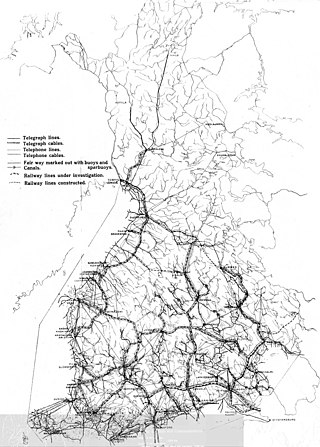Telecommunications in Belarus involves the availability and use of electronic devices and services, such as the telephone, television, radio or computer, for the purpose of communication.
Telecommunications in Burkina Faso include radio, television, fixed and mobile telephones, and the Internet.
Telecommunications in the Dominican Republic include radio, television, fixed and mobile telephones, and the Internet.

Telecommunications in Finland, as indicated by a 2022 European Commission index, highlight the country's significant role in the EU's digital sector. Finland has a high concentration of Information and Communication Technology (ICT) specialists and robust training programs, leading to notable expertise in technologies like AI and cloud computing. The nation has also made significant advancements in 5G technology. Additionally, Finland stands out for its high adoption of digital public services. The Finnish digital sector benefits from both the technology industry's contributions and government policies aimed at enhancing digital infrastructure and cybersecurity.

Telecommunications in Ghana include radio, television, fixed and mobile telephones, and the Internet.
Telecommunications in Lithuania include internet, radio, television, and telephony.
Telecommunications in Namibia include radio, television, fixed and mobile telephones, and the Internet.
Nepal's telecommunication network has increased over the years significantly, with the number of telephone users reaching 40,789,198 as of 14 May 2019.
Nigeria is Africa's largest ICT market, accounting for 82% of the continent's telecoms subscribers and 29% of internet usage. Globally, Nigeria ranks 11th in the absolute number of internet users and 7th in the absolute number of mobile phones.
Telecommunications in Poland include radio, television, fixed and mobile telephones, and the Internet.
Telecommunications in the Philippines are well-developed due to the presence of modern infrastructure facilities. The industry was deregulated in 1995 when President Fidel Ramos signed Republic Act No. 7925. This law opened the sector to more private players and improved the provision of telecom services are better and fairer rates, leading to the creation of many telecommunication service providers for mobile, fixed-line, Internet and other services.
Telecommunications in Slovakia includes fixed and mobile telephones, radio, television, and the Internet.
Telecommunications in Slovenia encompass internet, telephone, radio, and television services.
Telecommunications in Albania include radio, television, fixed and mobile telephones, and the Internet.
Telecommunications in Austria encompass highly developed and efficient internet and telephone networks, complemented by a number of radio and television broadcast stations.

Tet is a Latvian internet service provider, telecommunications, technology and entertainment company. It has also been an electricity service provider since 2017.
The Internet in Croatia became a reality in November 1992 when the first international connection linking Zagreb and Vienna became operational.
Internet in Estonia has one of the highest penetration rates in the world. In the first quarter of 2010, 75% out of 1.34 million people in the country used the Internet according to Statistics Estonia. In 2017, according to the World Bank came 13th in the world by the percentage of population using the Internet, with 88.1% people using it.
Telecommunications in Denmark encompasses a well-developed network of internet, telephone services, and broadcasting stations. Denmark has high internet connectivity and widespread mobile broadband adoption.
Telecommunications in Ivory Coast include radio, television, fixed and mobile telephones, and the Internet.



